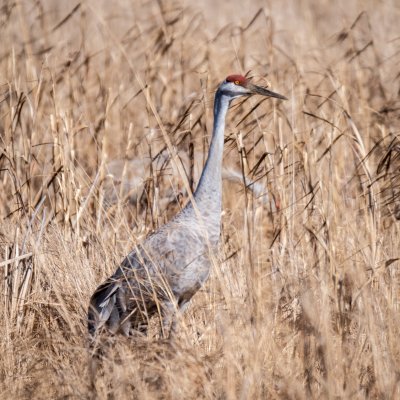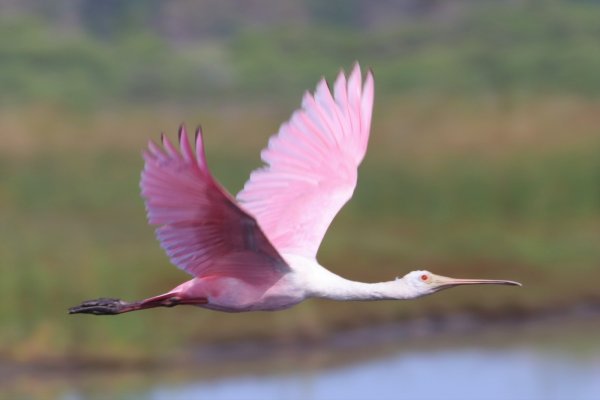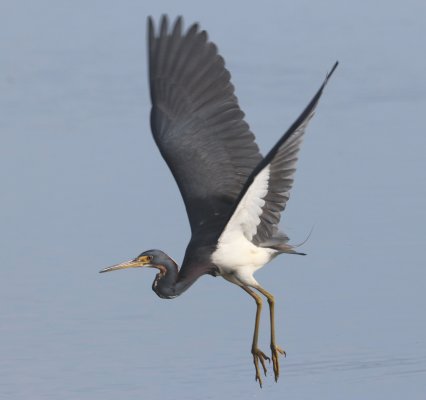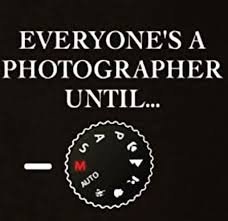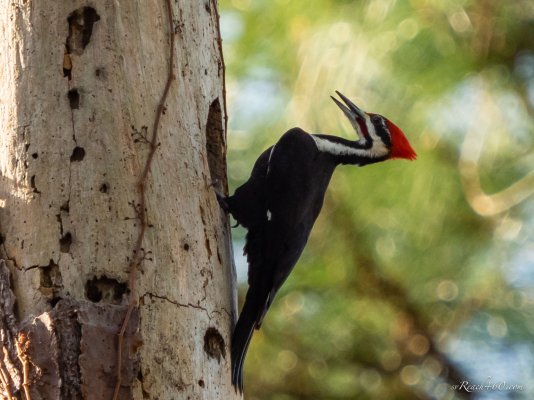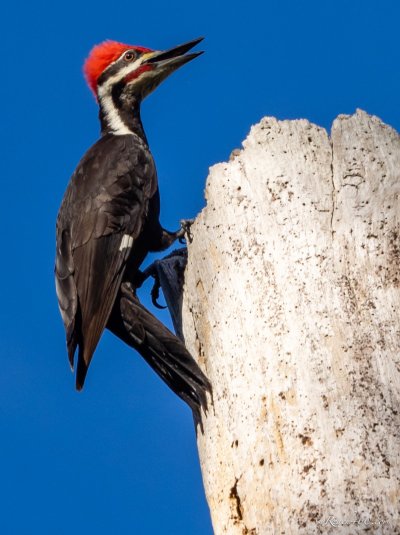You are using an out of date browser. It may not display this or other websites correctly.
You should upgrade or use an alternative browser.
You should upgrade or use an alternative browser.
Birding
- Thread starter Chuckanut
- Start date
stepford
Thinks s/he gets paid by the post
Spotted some sandhill cranes on today’s hike
I've always loved Sandhills. Saw this one on a roadtrip though New Mexico last fall:
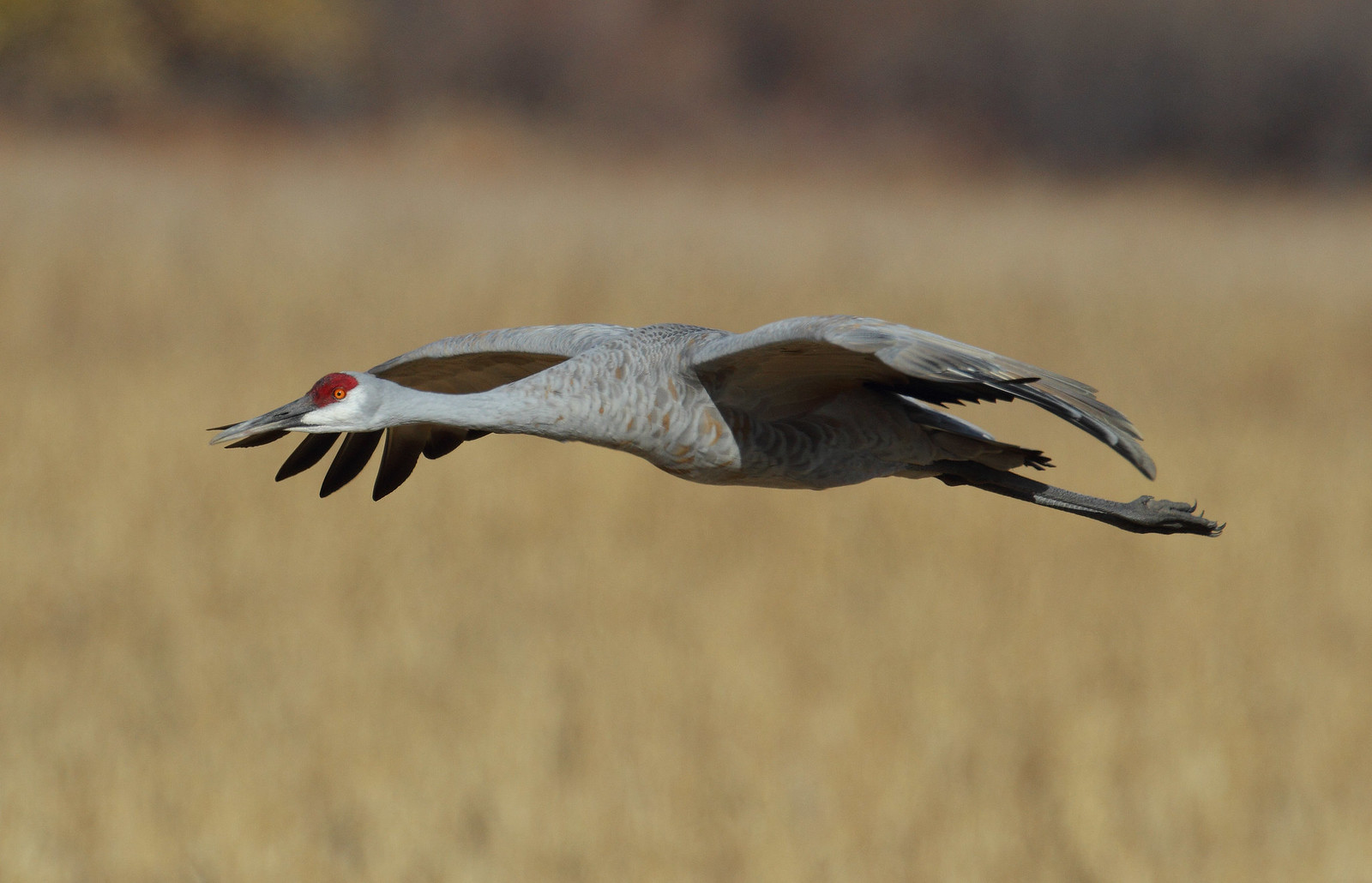
BoodaGazelle
Recycles dryer sheets
- Joined
- Mar 1, 2017
- Messages
- 284
Thanks. I tried to post my Painted Bunting, but the URL from Flickr did not show up... this is why I just posted the link to the site...
For all who are on this thread, Fort DeSoto in April truly is one of the premier bird watching spots in the country. Most of the warblers and tanagers photos were taken there. I would say that the 2nd week of April is the best if you were planning a trip.
For all who are on this thread, Fort DeSoto in April truly is one of the premier bird watching spots in the country. Most of the warblers and tanagers photos were taken there. I would say that the 2nd week of April is the best if you were planning a trip.
iloveyoga
Thinks s/he gets paid by the post
Yesterday I saw a blue heron flying in my neighborhood, that was a first. I have seen them at our local ponds before.
athena53
Give me a museum and I'll fill it. (Picasso) Give me a forum ...
- Joined
- May 11, 2014
- Messages
- 7,383
I saw a flock of what I thought were common ducks, until they started diving in groups. Took a pic, they were Buffleheads which are uncommon in our area. Possibly migrating.
I live on a lake in a Kansas City suburb and they come through every year about this time. Very distinctive with their stark black and white coloring! I keep bird feeders out year-round and a hummingbird feeder in warm weather. I mostly get the common varieties- plenty of sparrows and house finches but am starting to see goldfinches. Downy woodpeckers like my suet cakes.
This year for the first time I participated in the Great Back Yard Bird Count last month. I spent part of the weekend in Des Moines with DS and family and thought it would be a great learning experience for my granddaughters, but they don't ordinarily put seed out and even though I put some out on Friday we saw zero birds over the weekend! Weather was cold and a bit snowy and a friend suggested that maybe the birds were sticking to known feeding areas. Fortunately I got home early enough on Monday to log a few species at my feeder as well as Canada geese (of course) and a bufflehead in the lake.
SpinDoctorTX
Recycles dryer sheets
There are a lot of Bird Watchers out there. I am betting there are some here also. So, I thought I would start a thread on the general subject of Birding.
Why? Well, though I know little about birds, I find them interesting. If I had to come back as an animal, it would probably be a bird of some type like a kestrel. And birding can be done almost anywhere with a minimum of 'gear' needed.
Great topic! We love birds although we're just amateurs when it comes to Identifying them. To bring birds to our yard, we maintain several bird feeders + hummingbird feeders (AKA "cat TV"). DH belongs to a group of "old men with cameras"- and yes that is the group name, and it has kept him way more active than I can by "nagging", so I'm grateful. I admit I'm quite the pest about keeping him more active, as he's a 72 yo recent cancer survivor.
We went to visit friends in the Corpus Christi area last weekend, and came home with pics of the Whooping Cranes (there are only 508 or so left) and a bunch of other kinds of marsh & seaside birds.
I've no real interest in photography except for capturing memories, but I sometimes tag along when the wives are invited attend the OMWC group for the ride if there is any hiking to do.
We have one that frequents the large pond/small lake up the street. While nervous, I've gotten within about 20' walking past with it standing in a foot of water. Most often takes off & flies to other end of lake.Yesterday I saw a blue heron flying in my neighborhood, that was a first. I have seen them at our local ponds before.
Saw red wing blackbird there last week for first time this year. Their color is fun to see when they fly.
That's over 400 more than there were 40-50 years ago.We went to visit friends in the Corpus Christi area last weekend, and came home with pics of the Whooping Cranes (there are only 508 or so left) and a bunch of other kinds of marsh & seaside birds.
Was a second colony established with sandhills? That was tried at one point.
SpinDoctorTX
Recycles dryer sheets
I got this off the web but very quick look, "The U.S. Fish and Wildlife Services reported the Coastal Bend could expect to see between 412 and 660 whooping cranes this season.
"The population has really stayed stable," Turkett said. "We had a pretty good nesting year in Canada. The birds don't nest in Texas, but there were 97 nests recorded."
The International Crane Foundation calls the whooping crane one of conservation's most inspiring stories. The species dipped to a low of fewer than 20 cranes in the 1940s, with every whooping crane on earth living in the Aransas Pass National Wildlife Refuge.
"Aransas Pass Wildlife Refuge is a really cool site," Turkett said. "At a point, all of the living cranes in existence were living there, so it's the original home of the modern whooping crane.""
"The population has really stayed stable," Turkett said. "We had a pretty good nesting year in Canada. The birds don't nest in Texas, but there were 97 nests recorded."
The International Crane Foundation calls the whooping crane one of conservation's most inspiring stories. The species dipped to a low of fewer than 20 cranes in the 1940s, with every whooping crane on earth living in the Aransas Pass National Wildlife Refuge.
"Aransas Pass Wildlife Refuge is a really cool site," Turkett said. "At a point, all of the living cranes in existence were living there, so it's the original home of the modern whooping crane.""
zinger1457
Thinks s/he gets paid by the post
- Joined
- Jul 22, 2007
- Messages
- 3,230
We retired to a small community 3 miles from New Mexico and 30 miles north of Old Mexico. The birding is so great here because mexican birds don't pay attention to the border and travel the 30 miles in the mountains to mi casa. Cave Creek Canyon in Portal is famous for birds and other critters. we also have 8 rattlesnake species 1 venomous Coral snake and Ghia monsters to round things out.
Sounds like you're also very close to some popular spots for observing sandhill cranes during the winter time. I've been to the Whitewater Draw Wildlife Area to observe the sandhill cranes and it's an impressive site, it's on the other side of the Chiricahua's from your location.
We've had a hummingbird feeder outside our kitchen window for years and enjoy watching them. But I just started bird watching more frequently in January. I made a bird feeder and put it about 30' from my home office window. Then I set up my camera on a tripod in my office and I take photos of the birds through the window. Mostly cardinals, chickadees, red bellied woodpeckers, house finches, titmice.
I take my camera and a telephoto lens hiking a couple times a week. Mainly in search of bald eagles and pileated woodpeckers. I've seen several of both, but haven't got a good photo of the pileated woodpeckers yet.
Great pic, Ronstar!
harllee
Give me a museum and I'll fill it. (Picasso) Give me a forum ...
Went for a birding walk today, beautiful day. In an hour I saw 20 different species including some first of the season warblers. No one else was on the trail so I was social distancing. Speaking of social distancing I think I will use this time while I am staying home more to brush up on my skills of bird identification by sound. I am pretty good at identifying birds if I can see them but I feel my ability to identify bird solely by sound is lacking and I would like to improve that. Anyone have any suggestions for programs/software/websites/apps to help me identify birds by sound?
BoodaGazelle
Recycles dryer sheets
- Joined
- Mar 1, 2017
- Messages
- 284
harley
Give me a museum and I'll fill it. (Picasso) Give me a forum ...
I got inspired, so I went to Myakka River State Park in Sarasota, FL... it is a great spot. Here are two flight shots from today... my best Roseate Spoonbill ever, and a Tri-colored Heron.
Wow! Great shots!!
BoodaGazelle
Recycles dryer sheets
- Joined
- Mar 1, 2017
- Messages
- 284
Thanks for the kind words. All photography requires spending a lot of time in the field. An old expression was “f8 and being there”, which refers to an F-stop on the camera... the joke being that if you weren’t “there” you wouldn’t get the shot.
Also, with birds, it is difficult because they are often/mostly moving. Modern digital cameras, with their ability to set the ISO speed and shutter speed for each shot, help. The best advice I can give to budding bird photographers is to make sure your lens is wide open, i.e., use the smallest aperture you can. You need as much light as you can get, for the second part: shoot the fastest shutter speed to stop the action... Modern cameras in their auto modes will adjust based on the lighting... this can lead to bad exposures, because the camera doesn’t know that the thing you are taking a photo of is moving.
Finally, there is a lot of luck involved, especially for flight shots like those above. I use my Canon 80D with a 100-400 zoom that has “image stabilization”, and also they have a feature called “AI Servo”, which means that their autofocus *will* try to keep up with a moving subject. Still, with digital, you can take hundreds of photos, and simply throw away the bad ones. It is not an exaggeration to say that I probably only keep 1 percent that I consider professional quality images.
Also, with birds, it is difficult because they are often/mostly moving. Modern digital cameras, with their ability to set the ISO speed and shutter speed for each shot, help. The best advice I can give to budding bird photographers is to make sure your lens is wide open, i.e., use the smallest aperture you can. You need as much light as you can get, for the second part: shoot the fastest shutter speed to stop the action... Modern cameras in their auto modes will adjust based on the lighting... this can lead to bad exposures, because the camera doesn’t know that the thing you are taking a photo of is moving.
Finally, there is a lot of luck involved, especially for flight shots like those above. I use my Canon 80D with a 100-400 zoom that has “image stabilization”, and also they have a feature called “AI Servo”, which means that their autofocus *will* try to keep up with a moving subject. Still, with digital, you can take hundreds of photos, and simply throw away the bad ones. It is not an exaggeration to say that I probably only keep 1 percent that I consider professional quality images.
grasshopper
Thinks s/he gets paid by the post
- Joined
- Oct 9, 2010
- Messages
- 2,475
One of these days I am going to get a nice camera for catching my hummers. My last two camera purchases were for underwater turtle action, and kayaking use. Great photos everyone.
harllee
Give me a museum and I'll fill it. (Picasso) Give me a forum ...
BoodaGazelle (interesting name!). Thanks for those great pictures!
grasshopper
Thinks s/he gets paid by the post
- Joined
- Oct 9, 2010
- Messages
- 2,475
Yesterday was a two Cardinal day, a male Northern Cardinal and our resident Pyrrhuloxia AKA Mexican Cardinal. Although throughout the south and central Arizona, my property is grassland/ chaparral and N.Cardinals only show up about once a year.
Last edited:
I signed up for a birding class a while back; I was the newbie in the group.
I learned, quickly, some of the unusual names for the various birds we saw.
For example (yes, this is a true story), I saw a pretty jet black bird. I asked, "What's that black bird with the red wings called?" The leader's answer: "Oh, that's a red-wing blackbird." Now I know.
I learned, quickly, some of the unusual names for the various birds we saw.
For example (yes, this is a true story), I saw a pretty jet black bird. I asked, "What's that black bird with the red wings called?" The leader's answer: "Oh, that's a red-wing blackbird." Now I know.
stepford
Thinks s/he gets paid by the post
I got inspired, so I went to Myakka River State Park in Sarasota, FL... it is a great spot. Here are two flight shots from today... my best Roseate Spoonbill ever, and a Tri-colored Heron.
Thank you for those BoodaGazelle. When I used to go birding in FL it was always special for me to see a Roseate Spoonbill. Such a gorgeous bird. I've never gotten a great shot of one in flight though. I've seen Tri-color Herons more frequently, but always enjoyed spotting them. Here's a couple of mine from the Everglades a few years back:
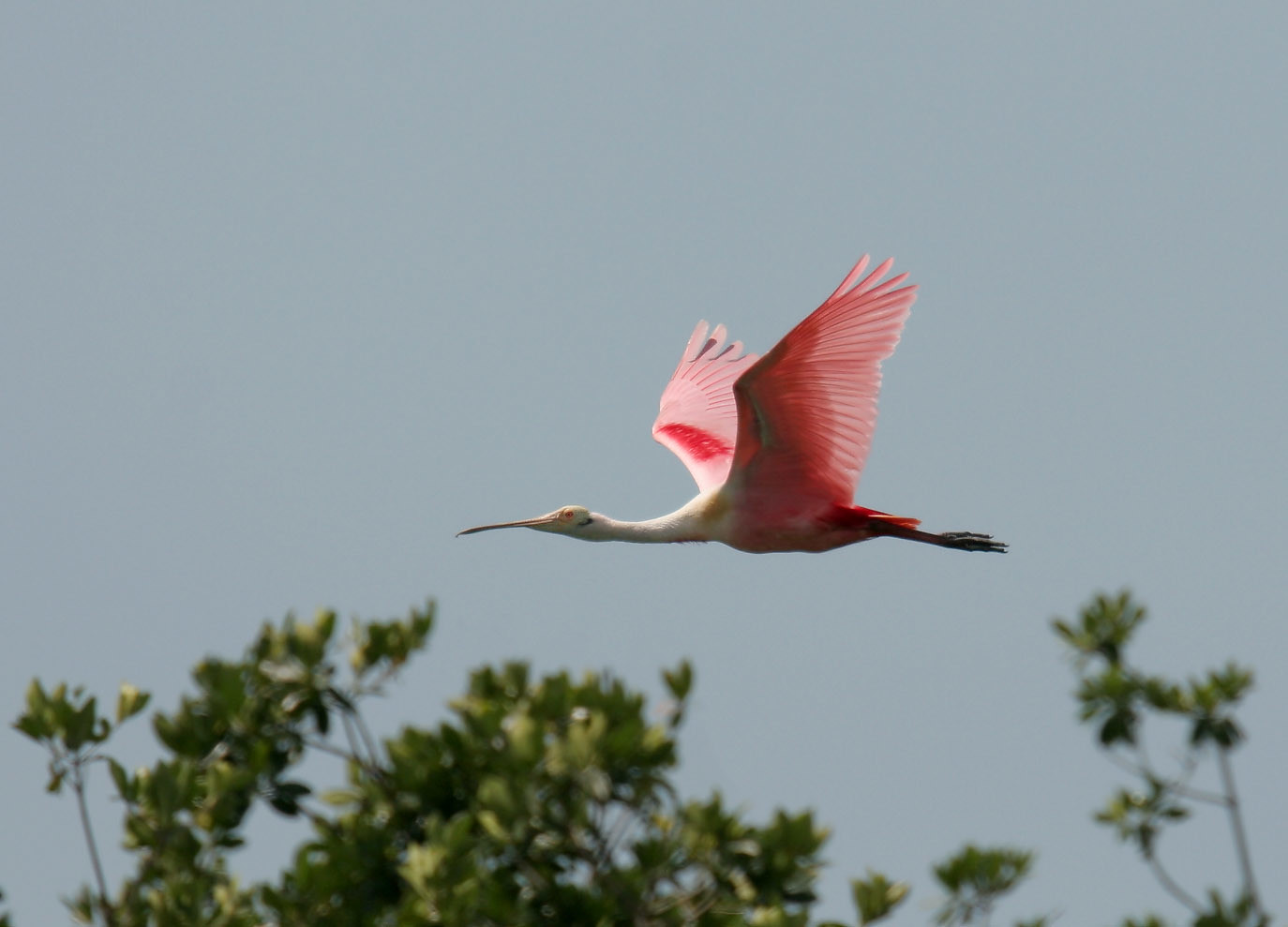
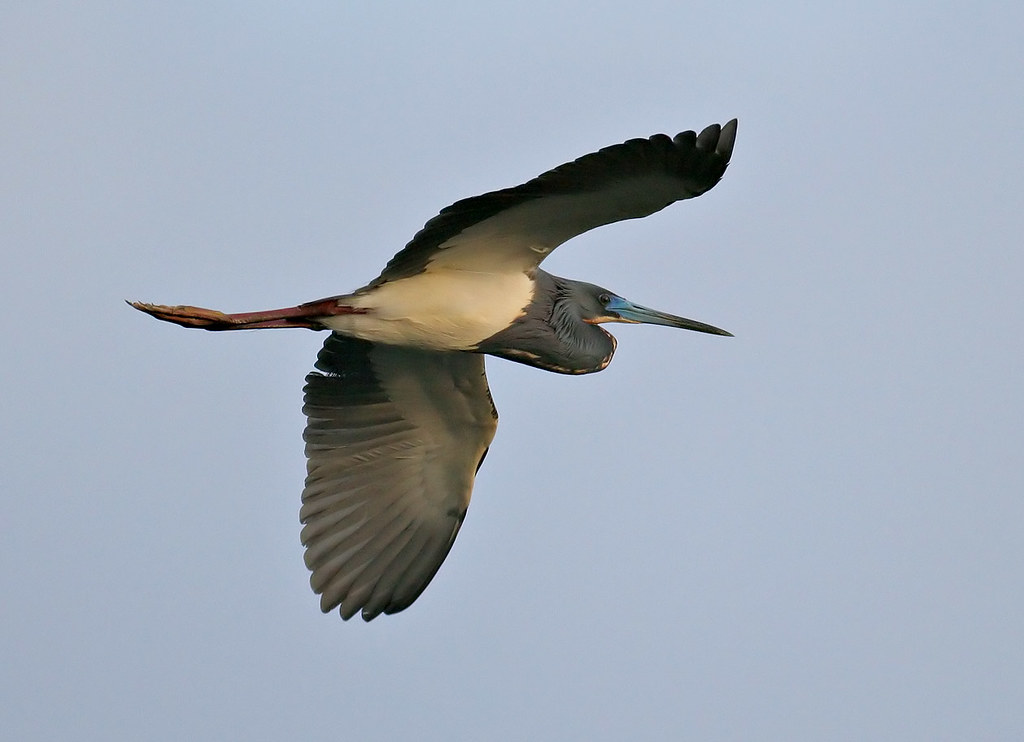
BoodaGazelle
Recycles dryer sheets
- Joined
- Mar 1, 2017
- Messages
- 284
BoodaGazelle (interesting name!). Thanks for those great pictures!
As you can imagine, there is a story behind the name. It's mostly just a silly one... nothing else.
Reach
Recycles dryer sheets
- Joined
- Nov 4, 2011
- Messages
- 69
Avid birder here! I've been self-taught for the last 10 years or so, just by having an affinity for birds, underwater and nature photography (just a hobby) . I completely agree with the discussion about such hobbies building an increased awareness of the worlds around you.
Although I love the alone-time of birding, I started getting serious last year by hooking up with local Audubon societies in new places where I travel. This has been a great way to expand my experience, gain local knowledge and meet like-minded bird geeks. Ebird has a great map to find local birding areas around the world (https://ebird.org/hotspots).
I now know enough to mention that Boodagazelle's roseate spoonbill is a juvenile, while Stepford's is an adult (Adults are bald headed). Spending this winter in SW Florida has been great for feeding my birding habit, where I venture out for hours, several times a week.
(Adults are bald headed). Spending this winter in SW Florida has been great for feeding my birding habit, where I venture out for hours, several times a week.
I'm looking forward to spring migration and have also used this map as a reference, using radar as the OP alluded to: https://birdcast.info/live-migration-maps/
Finally, one poster was in search of pileated woodpecker, so here's hoping that you'll find one as close as I did last month. (PS This one is a male, with red on cheek)
Although I love the alone-time of birding, I started getting serious last year by hooking up with local Audubon societies in new places where I travel. This has been a great way to expand my experience, gain local knowledge and meet like-minded bird geeks. Ebird has a great map to find local birding areas around the world (https://ebird.org/hotspots).
I now know enough to mention that Boodagazelle's roseate spoonbill is a juvenile, while Stepford's is an adult
I'm looking forward to spring migration and have also used this map as a reference, using radar as the OP alluded to: https://birdcast.info/live-migration-maps/
Finally, one poster was in search of pileated woodpecker, so here's hoping that you'll find one as close as I did last month. (PS This one is a male, with red on cheek)
Attachments
Last edited:
Mr._Graybeard
Thinks s/he gets paid by the post
- Joined
- Apr 18, 2011
- Messages
- 2,981
Thank you for those BoodaGazelle. When I used to go birding in FL it was always special for me to see a Roseate Spoonbill. Such a gorgeous bird. I've never gotten a great shot of one in flight though. I've seen Tri-color Herons more frequently, but always enjoyed spotting them. Here's a couple of mine from the Everglades a few years back:

One of the most amazing birding flights I've ever seen was a sunset cruise on Florida Bay near the old Flamingo Visitor Center in the Everglades. As the sun went down thousands of birds came in from their feeding areas to roost. The sight was simply unforgettable.
I thought of this thread this afternoon because a flock of tundra swans are feeding today in the wetland behind my house. Their call sounds a little like a sandhill crane's, but not as loud.
harllee
Give me a museum and I'll fill it. (Picasso) Give me a forum ...
While we are social distancing I am trying to learn to ID more birds solely by sound. Today I went on a hike at my favorite birding spot and identified 15 different bird species by sound alone in about half and hour so I am making progress. I have the most trouble identifying warblers by sound.
Similar threads
- Replies
- 3
- Views
- 777
- Replies
- 87
- Views
- 9K

